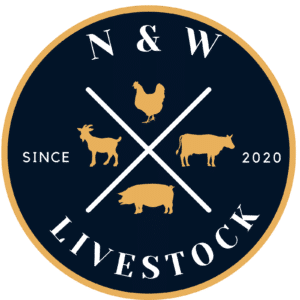Raising Poddy Calves
Not only a cuteness overload, it is a highly rewarding experience and fantastic life lesson for kids to be a part off, it’s even better for the adults. Calves that have come from the dairy industry are referred to as Poddy or Bobby calves.
These calves must be at least 5 days old in order to be transported but there is also a few other things you need to know before making the decision to adopt. Below is a heap of valuable information specifically for people in NSW Australia..
Our calves are trained on “Peach Teats” this is a style not a colour, this usually takes a few days for them to master. All calves are fed MaxCare calf milk replacer and we highly recommend keeping them on this same formula.
All Calves Have Had:
- Colostrum
- ADE Injection
- B Complex Injection
- Probiotics
- NLIS Tagged
- Identification Tags
- Completed paperwork for transport.
*Strictly pickup only from Glenorie NSW.
You will need suitable transport, box trailer / horse float etc.
NOTE: We do not recommend using a transport company they will get sick. Hygiene standards aren’t often great.

What Does A Calf Need?
- All calves will need to be bottle fed twice a day using a quality calf milk replacer (CMR). Note: Milk feeding can be reduced to 4L once a day at around 4 weeks of age.
- Calves will need access to calf starter pellets 24/7 of at least 20% protein from 1 week of age.
- It’s recommended they have access to a shelter at night and area to run and play during the day.
-
Sale!
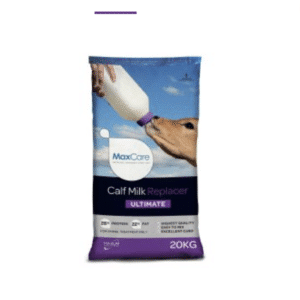
MaxCare Ultimate CMR – 20Kg
$202.40Original price was: $202.40.$189.95Current price is: $189.95. Add to cart -
Sale!
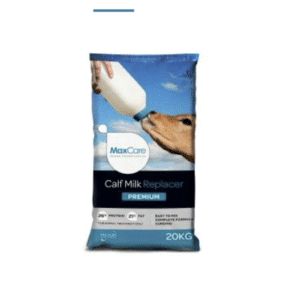
MaxCare Premium CMR 20Kg
$190.00Original price was: $190.00.$179.90Current price is: $179.90. Add to cart -
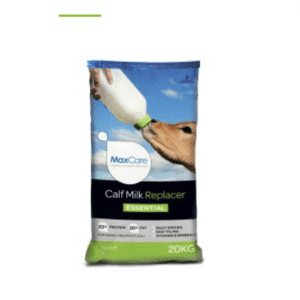
MaxCare Essential CMR 20Kg
$146.50 Add to cart -
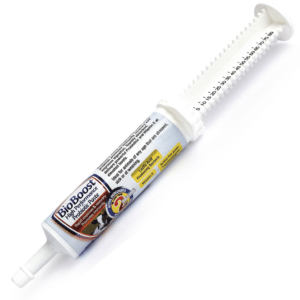
BioBoost – Probiotic Paste
$39.95 – $92.50 Select options This product has multiple variants. The options may be chosen on the product page
Can Calves be Kept Alone
There is a lot of debate over this topic from people who claim to have successfully kept cows on their own with paddock mates from others species, e.g. Horses, pigs, sheep and goats etc.
Here is our experience:
Our first cow “Lola”, a poddy calf, kept alone. Lola was kept right next to the house, we had staff and visitors coming and going everyday, she got plenty of attention.
All is good, at 4 weeks, Lola was moved to the sheep paddock to live with some “friends”. She loved it, they loved it. No issues, was lovely to see.
Fast forward to 4-6 months old, Lola is starting to get a bit rough with her herd mates, Lola now sits at the top of the pecking order and even the ram is no match for Lola. We noticed that Lola was starting to become the outcast, they all still sleep together at night but during the day, the others didn’t want her hanging around and they would keep moving away when she came over.
Skip forward to 9 months, Lola goes into season for the first time. WOW we thought she was being killed, she was screaming nonstop, it was incredible it’s a high pitch bellow that shook the earth. (Important to note if you want a heifer, this happens every 21 days) Lola was calling for a bull, this was the moment we realised, Lola isn’t happy she needs to have other herd mates.
Here was the problem, an adult steer is too big, another weaned poddy calf is too small. This was the moment we realised we wish we had raised two at once.
The other import thing we learnt was that feeding time for a mixed herd was starting to become a challenge, Lola or as commonly referred to here as “Fat Lola” was as her nickname suggests, obsessed with food which meant no-one else was eating until she was done, we started to notice the sheep’s condition was deteriorating so we needed to start separating them to feed.
So in summary, the answer is “maybe” but it’s going to come with challenges. In our opinion it’s much easier to just have two cows, long term way less hassle.






Environmental Enrichment
Caring for bottle fed calves comes with a tone of challenges and one often overlooked is the importance of providing environmental enrichment. Unfortunately navigating the line between hygiene, nutritional development and enrichment can lead to a contradiction in approaches.
Raising calves with herd mates is important to lower stress offering them someone to play with, however this leads to hygiene issues, given they tend to suckle on each other and transfer viruses and bacterial infections.
From a nutritional standpoint feeding hay provides little to no benefit until they have a fully functional rumen, this is likely to be between the age of 2-3months or when they are consuming 1Kg of grain per day, therefore, its recommended to not feed calves hay before weaning, however, the inclusion of hay does provide environmental enrichment.
Bottom line, calves like to play, providing enrichment is going to lower stress, improve attitude and overall provide happy healthier calves. Happy calves gain weight.
CAUTION: As calves are highly inquisitive, often with their mouths, be careful of the environment you rear them in, check to make sure anything toxic is removed, peeling paint, plants, weeds, dirty water etc, and that the area is kept clean. Poor hygiene is one of the biggest issues with calf rearing.
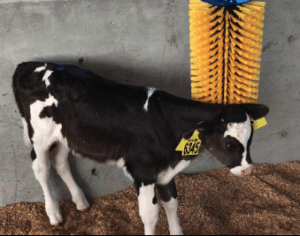
What to Look for in a Calf
The older the calf, typically the more established its immune system and rumen development therefore the less experience required to raise.
When you first meet your calves there are a few things to look out for:
- How friendly are they? If a calf has been raised on a bottle they aren’t scared of people.
- Do they have clear eyes? A discharge can be a sign of illness and should be avoided.
- Do they have a runny nose? Do they have a cough? One of the biggest killers in calves is phenomena that’s been left untreated.
- Do they have a swollen navel “Umbilical cord”? The umbilical cord must be kept clean and be regularly sprayed with iodine solution to keep it sterile and clean. A wet and swollen navel can be signs of infection.
- How does their coat look? A shinny and healthy looking coat generally means a healthy calf.
- Do they have a suck reflex, Calves are milk drinking machines and a healthy calf will try sucking milk from anything it can attach to.
- Is the calf lying down? A calf that’s not up and about is something to look out for.
- Does the calfs mouth feel hot? Calves temperature is a critical piece of information in early detection of illness. A normal calves temp range is 38.6-39.4°Celsius
We share this information not to scare you but to be transparent, rearing a calf through the first few weeks of life is an art, once they are 3 weeks and older it’s smooth sailing and a really enjoyable experience. Let’s be honest, they are super cute and it really is so rewarding.
How Long Do Calves Need Milk
A calf requires ideally 8-12 weeks on calf milk replacer (CMR) fed twice a day 10-12 hours apart. Each CMR recommends different volumes but generally is 4L a day in total. A week before weaning you would swap from feeding 2L morning and night to feeding 4L at night only.
Some calves that have been offered a premium feed from birth can be weaned as early as 6 weeks but this is typically not encouraged, ultimately the length of time is determined by how prepared the calf is for weaning.
Calves need in addition to milk free access to calf starter pellets. This is what develops their rumen. From a nutritional standpoint, calves should not be fed hay until they are weaned. See above “Environmental Enrichment”.
When Can a Calf be Weaned
As a guide a calf can be weaned when it’s consuming “adequate” hard feed, 1 to 1.5Kg per day, this can be as early as 6 weeks of age, more commonly it happens around 8-12 weeks.
From the first time a calf starts eating pellets, the rumen takes 28 days to develop and allow for weaning, It takes around 12-18 weeks to be able process hay. This is key when deciding on the right time to wean.
The decision to wean should not be dictated by age, it comes down to intake of hard feeds and water. Age is a great tool for forecasting but if a calf isn’t consuming enough feed or has been on lower quality feed it will most likely need to remain on CMR until its older. Some calves will stay on formula until 16-20 weeks,
When a calves hard feed/grain consumption is developed early on in life, 300g per day from 2 weeks old, weaning can be earlier, around 6-8 weeks, but be warned, weaning a calf too early will impact it’s development and may result in a smaller, weaker calf. If you are planning to be weaning a calf around 6-8 weeks you will need to be very aware of individual consumption levels.
How to Wean A Calf
The weaning process involves the reduction of milk and the increase in hard feed e.g. Calf starter pellets. Avoid offering hay until they are weaned, hay distracts the calf from eating pellets and serves little nutritional benefit or despite popular belief little assistance to rumen development. They need calf starter pellets with protein around 20-22%.
WARNING: Do not water down the milk, always stick to the recommended mixing ratio. Milk needs to clot in the abomasum to be absorbed. Watered down milk prevents this from happening and your calves will loose condition quickly.
Start by reducing feeding from twice a day to a single feed at night. It’s recommended to feed at night simply because temperatures tend to drop and the calf requires energy to stay warm.
When reducing the number of feeds in a day you increase the volume of milk offered. For example if you have been feeding 2L in the morning and 2L at night you would now feed 4L at night. Calves will need to be consuming around 1-1.5Kg of pellets (Not Hay) and drinking around 5-10% of bodyweight of water in-order for weaning to be carried out.
As the calves are cut back to once a day this would continue for 1 week, at the end of that week you would start reducing the volume of milk offered each day, 3L for 3 Days, 2L for 2 days, 1L for 2 days then we skip a day offer a 1L skip a day offer a 1L and then cut them off. As you tapper the milk off it’s critical you stay on top of hydration levels. It’s going to be dehydration that is your issue more so that nutritional deficiency.
Be prepared for the calves to be screaming, they aren’t going to be fans of this weaning business, if the screaming becomes too much, offer them some electrolytes or warm water in a bottle instead of milk.
Should Calves Eat Hay
Calves can’t process hay until they are 8-12 weeks old therefore it serves no nutritional benefit until the rumen is developed. In fact hay is believed to potentially slow the calves development by distracting the calf from eating hard feed.
Hay should be offered after weaning and only offer high quality hay, as much as they want to eat.
Feeding - Do's and Don'ts
One of the biggest mistakes people make when it comes to calves is not appreciating the importance of having a super strict routine and even stricter protocols in hygiene, how you mix up the formula, the temperature of the milk and the volume each calf is fed.
The good news, calves require feeding twice a day, ideally 10-12 hours apart, for examples we feed at 6am and 4pm everyday come rain, hail or shine. So no where as needy as some livestock.
Calves need to consume 10% of body weight per day to survive + what has been lost in scouring + catch up dehydration.
WARNING: If calves don’t drink the minimum per day they will require intervention by way of tube feeding https://nwlivestock.com.au/
From 1 week old calves should be provided with free choice access a high quality calf starter pellets containing 20-22% proteins. The consumption of hard feeds is what will activate the remaining 3 stomachs to enable the calf to be weaned later in life
-
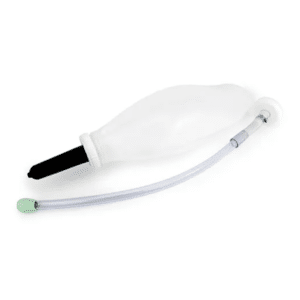
Calf Drencher Springer-Magrath 2L
$64.95 Add to cart -
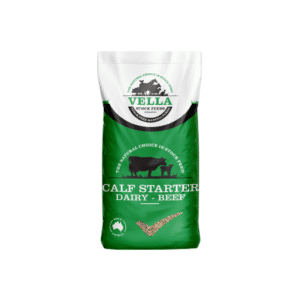
Vella Calf Starter – 20Kg
$25.00 Add to cart -
Sale!
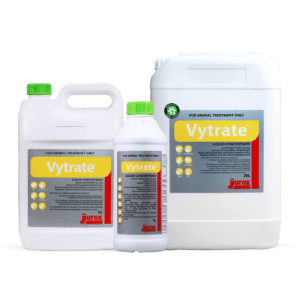
Vytrate (Non-Antibiotic Scour Treatment)
$7.50 – $134.95 Select options This product has multiple variants. The options may be chosen on the product page
Feeding Equipment - Bottle vs Bucket
Calves should be drinking from bottles or fence feeders over buckets in our opinion but this is widely debated.
The basis of our opinion is to do with how a calf drinks and what happens inside the calf.
Cattle are ruminant animals which means they have 4 stomachs, these stomachs are essentially a super sophisticated fermentation tanks that can extract nutrients from grass. The stomachs are called the Rumen, Reticulum, Omasum and Abomasum.
When a calf is born it only has one stomach that works, this stomach was activated by the mothers colostrum, this stomach is called the abomasum or “true stomach” and for the first 4 weeks of life is designed to clot milk to enable the body to extract what it needs.
-
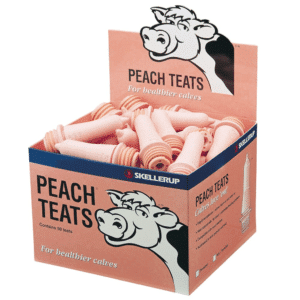
Peach Teat (Replacement Teat)
$8.95 – $353.50 Select options This product has multiple variants. The options may be chosen on the product page
In order for milk to pass directly to this stomach and bypass the other 3 an esophageal groove needs to be triggered essentially creating a by-pass sending the milk directly to the Abomasum. The sucking reflex from drinking from Peach Teats (not a colour, a style of teat) and milk proteins will trigger this groove to open.
Milk that collects in the other stomachs won’t be processed, will ferment and go bad causing all sorts of issues.
If you are going to be feeding from a bucket, the bucket must be raised 30cm off the floor to also trigger the groove, but there is an increased chance of Aspiration (fluid on lungs) which then increases chances of pneumonia.
If you decide to use a bucket due to the ease of feeding, we would suggest only doing so in calves 4 weeks older or more as they have most likely learnt how to drink water thereby the chance of aspiration is decreased.
The major takeaway here is that a small change in any of these things can lead to calves scouring or”diarrhoea” which leads to dehydration. 92% of calves that die from illness die from dehydration not the illness.
Transportation Checklist
To be transported for sale calves must be at least five days old, bright and alert, actively mobile and with no signs of disease such as scours, nasal discharge, cough etc.
- Calf vendors must have a system in place to accurately age and ensure calves are older than five days before they can leave the farm. The navel must be dry and the hooves firm and worn flat, and not bulbous with soft unworn tissue. These are additional indicators the calf is older than five days and thus able to travel.
The calf must have been fed milk within the last six hours.
The calf must has an NLIS tag (it is illegal for cattle to leave a property in Australia without an NLIS tag).
The Producer must have completed a Bobby Calf National Cattle Vendor (NVD) Declaration.
If purchasing direct from the calf producer you must transfer the NLIS tag to your property within seven days
The Producer has completed a National Cattle Health Declaration. This is an optional but very valuable step as it will give you a lot of additional information on the management of the calf to date.
You have an appropriate livestock trailer that
has protection from the heat and cold (eg wind protection on front and shade protection on top) and the trailer has thick bedding (15cm) and room to lie down.Transport is less than six hours
Ideal transportation would be a partially enclosed (Roof and front) cattle trailer or horse float. Ensure the calves have adequate grip, they will stand up to urinate and defecate despite being in transit and without grip injuries are possible and the calves get stressed. Stressed calves start scouring, scouring leads to dehydration. Dehydration can be fatal.
Sick, injured or dehydrated calves should not be transported unless it’s to the vet.
When you are transporting a calf to a new property it’s likely the calf has no immunity to the problems you may have.
Know what your property has before bringing a calf home and follow basic quarantine protocols whilst your calves start to develop their own immunity.
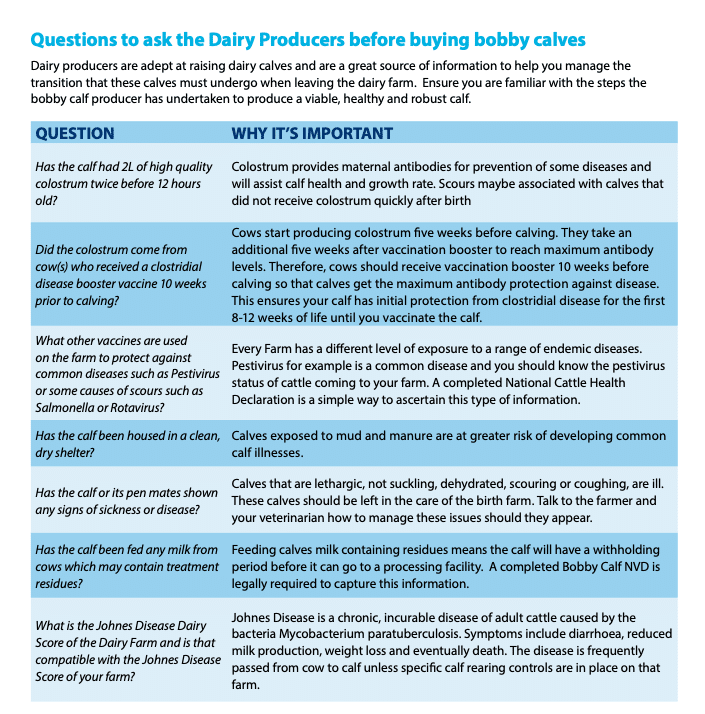
Colostrum Why It's Important
When a calf is born it requires at least 4L of colostrum within the first 12 hours of life. This colostrum is provided by its mother and contains all the good stuff to get the rumen started and pass on antibodies to be able to survive outside the womb.
Antibodies passed on from the mother tend to only be effective for the location the mother was grazing, when a calf is transported and exposed to a new environment this immunity may no longer be adequate.
Calves that don’t receive enough colostrum will most likely result in underdevelopment both mentally and physically and are 3x more likely to result in fatality within the first few weeks of life.
We refer to a lack of colostrum as Failure Passive Transfer “FPT”. This is one of the biggest issues with poddy calves.
The older a calf, the more established its immune system and rumen development therefore the less experience required to raise. Someone new to calves should be looking at calves 4 weeks or older.
Calf Care
The single most important tool you can have on hand is a rectal thermometer. Calves that are unwell will often present with a temperature before obvious signs are detected. A calves temp should be between 38.6-39.4°Celsius.
The major causes of death in calves comes from poor hygiene, dirty bedding, wet and cold pens and pre-existing diseases and viruses, incorrectly mixing formula, overfeeding and finally stress. These all lead to calves scouring or “diarrhoea” which leads to dehydration. 92% of calves that die, don’t die from illness, they die from dehydration.
SCOURING: When a calf is stressed, sick or has overeaten one of the early signs is scouring. Scouring can also be a sign of a virus, bacteria or pathogen so you will need to address the cause, but to start off, you need to treat the symptoms.
If you see scouring don’t wait, administer a probiotic like D-scour paste https://nwlivestock.com.au/
A shot of B-complex can also be administered this is going to aid in appetite and attitude. https://nwlivestock.com.au/product/vitamin-b-complex-injection/
Contact your local livestock vet and discuss treatment. If you can’t get a hold of a vet we can provide you guidance but you most likely will need prescription medications.
FAILURE TO DRINK: Calves need to consume 10% of body weight per day to survive + what has been lost in scouring + catch up dehydration. If calves don’t drink the minimum per day they will require intervention by way of tube feeding https://nwlivestock.com.au/
The longest a calf should go between feeds is 24 hours. A calf needs to ideally drink 50% of its daily intake every 12 hours. Skipping one feed is generally ok, skipping two can be fatal.
VACCINATIONS: There are 5 main diseases that calves get and in some cases cows are vaccinated prior to calving subsequently the antibodies are passed onto the calves providing some level of protection. Calves should be vaccinated at 8 weeks of age with a booster in 4 weeks.
When you are transporting a calf to a new property it’s likely the calf has no immunity to the problems you have. Know what your property has before bringing a calf home and follow basic quarantine protocols, we have a seperate area away from everything else that calves are raised in until they are weaned, eating grass and developing their own immunity.
DRENCHING: Calves like all livestock pickup parasites and protozoa, however this usually is not a problem until they start eating grass but in some cases they can pick it up sooner.
One of the most deadly is coccidia, transferred in faeces often from the cow the calf was suckling from. This protozoa attacks the intestines and destroys the calves ability to absorb nutrient and hydration, incubation for this is 16 days from exposure.
The best practise is to get a faecal egg count test done and treat as soon as you suspect an issue.
Paperwork - NVD (NSW)
You are legally required to ensure that all calves are NLIS tagged and that the appropriate paperwork accompanies them whilst in transport. Fines are $1100 per calf.
All calves traveling in NSW are required to be accompanied with a NVD (National Vendors Declaration) or TSS (Transport Stock Statement).
Transporting of all livestock in NSW requires that both parties involved in the transfer, both the seller and the buyer have a PIC (Property Identification Code).
If you don’t have a PIC you will need to apply for one here https://www.lls.nsw.gov.au/i-want-to/apply-for-a-property-identification-code








